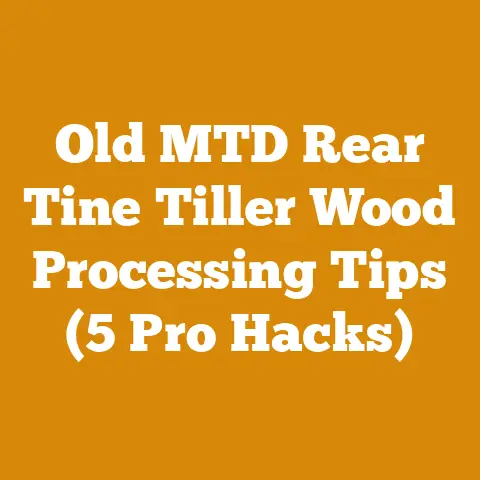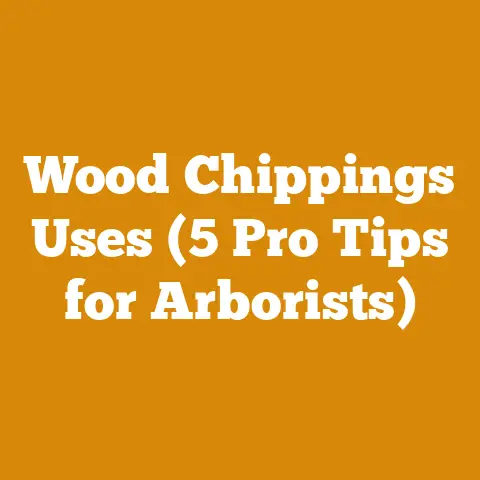Splinters from Pressure Treated Wood: 5 Safety Fixes (Pro Tips)
Must-Have Knowledge: Conquering Pressure Treated Wood Splinters – Your Ultimate Safety Guide
Let’s face it, working with pressure treated wood is a staple for many outdoor projects.
Decks, fences, raised garden beds – it’s everywhere.
But here’s the rub: those pesky splinters!
They’re not just annoying; they can be downright dangerous, especially with the chemicals used in pressure treatment.
I’ve had my fair share of splinter encounters over the years, from minor irritations to deeply embedded slivers that required some serious extraction maneuvers.
Trust me, prevention is key.
Key Takeaways You’ll Learn:
- The Real Danger: Understanding the specific risks of pressure treated wood splinters, including chemical exposure.
- Protective Gear is Non-Negotiable: A detailed breakdown of essential safety equipment – gloves, eye protection, and more.
- Tool Mastery: How the right tools and techniques can dramatically reduce splintering.
- Surface Smoothing Secrets: Pro tips for prepping pressure treated wood to minimize splinter potential.
- First Aid Essentials: What to do if a splinter does manage to sneak in.
So, grab your safety glasses (you’ll need them!), and let’s dive into the world of splinter-free (or at least, splinter-reduced) pressure treated wood projects.
The Pressure Treated Predicament: Understanding the Risks
Pressure treated wood is designed to resist rot, insects, and the elements.
That’s fantastic for longevity, but the treatment process itself introduces potential hazards.
The chemicals used – historically CCA (Chromated Copper Arsenate) and now often ACQ (Alkaline Copper Quaternary) or CA (Copper Azole) – can be irritants and, in some cases, pose long-term health risks if ingested or absorbed through the skin.
Data Point: While CCA is largely phased out for residential use, ACQ and CA are considered safer, but still require caution.
The EPA provides detailed information on the approved treatments and safe handling practices.
Always check the tag on the wood to identify the specific treatment used.
My Experience: I remember back in the day, working on a deck project with older CCA-treated lumber.
We were pretty lax about safety.
Looking back, I realize how foolish that was.
Now, I wouldn’t dream of touching pressure treated wood without proper gloves and eye protection.
The Splinter Connection: Splinters from pressure treated wood aren’t just about the physical discomfort.
They’re a direct route for these chemicals to enter your body.
That’s why taking splinter prevention seriously is crucial.
Gear Up for Glory: Essential Safety Equipment
Think of your safety gear as your armor against the splinter onslaught.
Don’t skimp on quality or assume you can get by without it.
1. Gloves: Your First Line of Defense
- Material Matters: Leather gloves offer excellent protection against punctures and abrasions, but they can be bulky.
Nitrile or latex gloves provide a closer fit and better dexterity, but may tear more easily.
I prefer a combination – a sturdy leather glove with a nitrile liner for added chemical protection. - Fit is Key: Gloves that are too loose can be cumbersome, while gloves that are too tight can restrict circulation.
Find a pair that fits snugly but allows for comfortable movement. - Replace Regularly: Don’t wait until your gloves are ripped and tattered.
Replace them as soon as you notice signs of wear and tear.
Pro Tip: Keep a box of disposable nitrile gloves handy for quick tasks like grabbing a single piece of wood or applying sealant.
2. Eye Protection: Shielding Your Sight
- Safety Glasses vs.
Goggles: Safety glasses are fine for general work, but goggles offer superior protection against dust, debris, and flying splinters.
If you’re using power tools or working overhead, goggles are a must. - ANSI Rating: Look for safety glasses or goggles with an ANSI Z87.1 rating.
This indicates that they meet a specific standard for impact resistance. - Comfort is Crucial: If your eye protection is uncomfortable, you’re less likely to wear it.
Choose a pair that fits well and doesn’t fog up easily.
My Experience: I once had a small splinter fly directly into my eye while cutting a piece of pressure treated wood.
Thankfully, I was wearing safety glasses.
It was a close call, and it reinforced the importance of always protecting my eyes.
3. Respiratory Protection: Breathing Easy
- Dust Masks vs.
Respirators: A basic dust mask can filter out larger particles, but a respirator with a particulate filter is necessary for finer dust and chemical fumes. - Fit Testing: If you’re using a respirator, make sure it fits properly and forms a tight seal around your face.
A poorly fitting respirator is ineffective. - Ventilation is Vital: Whenever possible, work in a well-ventilated area to minimize exposure to dust and fumes.
Data Point: Studies have shown that even short-term exposure to wood dust can irritate the respiratory system.
Long-term exposure can lead to more serious health problems.
4. Protective Clothing: Covering Up
- Long Sleeves and Pants: These provide a physical barrier against splinters and chemical exposure.
- Work Boots: Sturdy work boots protect your feet from dropped lumber and stray splinters.
- Apron or Overalls: These can provide an extra layer of protection for your torso and legs.
Pro Tip: Launder your work clothes separately from your regular laundry to avoid transferring wood dust and chemicals to other garments.
Tool Time: Techniques to Tame the Splinter Beast
The right tools, used correctly, can make a world of difference in reducing splintering.
1. Saw Selection: Choosing Wisely
- Circular Saw: A versatile tool for cutting pressure treated wood, but can produce splintering, especially when cutting across the grain.
Use a sharp blade with a high tooth count (60+ teeth) designed for fine cuts. - Miter Saw: Excellent for making precise angle cuts with minimal splintering.
Again, a sharp, fine-tooth blade is essential. - Table Saw: Can produce clean cuts, but requires careful setup and technique.
Use a zero-clearance insert to minimize splintering around the blade. - Hand Saw: A good option for small cuts and delicate work.
Choose a saw with fine teeth and a comfortable handle.
My Experience: I’ve found that a good quality miter saw with a sharp blade is my go-to tool for most pressure treated wood projects.
The precise cuts and minimal splintering save me a lot of time and effort.
2. Cutting Techniques: Mastering the Art
- Sharp Blades are Key: A dull blade is more likely to tear the wood fibers, resulting in splintering.
Sharpen your blades regularly or replace them when they become dull. - Cut with the Grain: Whenever possible, cut with the grain of the wood.
This will help to prevent splintering. - Score the Cut Line: Before making a cut, score the cut line with a utility knife or scoring tool.
This will help to prevent the wood fibers from tearing. - Support the Wood: Properly support the wood to prevent it from vibrating or moving during the cut.
This will help to ensure a clean, splinter-free cut. - Slow and Steady Wins the Race: Don’t rush your cuts.
A slow, controlled cut is less likely to produce splintering than a fast, jerky cut.
Pro Tip: When cutting across the grain, apply masking tape to the cut line.
This will help to hold the wood fibers together and prevent splintering.
3. Drilling Strategies: Avoiding Blowout
- Sharp Drill Bits are Essential: A dull drill bit will tear the wood fibers and create splintering around the hole.
- Use a Brad Point Bit: Brad point bits are designed to create clean, precise holes with minimal splintering.
- Back Up the Wood: When drilling through wood, place a scrap piece of wood behind the piece you’re drilling.
This will help to prevent blowout on the back side of the hole. - Drill Slowly and Steadily: Don’t force the drill bit.
Let the bit do the work. - Counter Sink for Cleanliness: Use a countersink bit to create a beveled edge around the hole.
This will help to prevent splintering and provide a clean surface for screws or nails.
My Experience: I learned the hard way about the importance of backing up wood when drilling.
I was drilling a hole for a bolt in a piece of pressure treated lumber, and I didn’t use a backup piece.
The result was a large, ugly splinter on the back side of the hole.
Now, I always use a backup piece, and my holes are much cleaner.
4. Screwing Smart: No More Splits
- Pilot Holes are Your Friend: Always drill pilot holes before driving screws into pressure treated wood.
This will help to prevent the wood from splitting. - Use Self-Tapping Screws: Self-tapping screws are designed to cut their own threads as they are driven into the wood.
This reduces the risk of splitting. - Don’t Overtighten: Overtightening screws can cause the wood to split.
Tighten the screws until they are snug, but not so tight that they compress the wood fibers. - Use Deck Screws: Deck screws are specifically designed for use in pressure treated wood.
They are coated to resist corrosion and are less likely to react with the chemicals in the wood.
Data Point: Studies have shown that using pilot holes can reduce the risk of splitting by as much as 50%.
Smoothing Strategies: The Path to a Splinter-Free Surface
Once you’ve cut and drilled your pressure treated wood, it’s time to smooth out any rough edges and splinters.
1. Sanding Sensibly: A Gentle Approach
- Start with Coarse Grit: Begin with a coarse grit sandpaper (80-grit) to remove any large splinters or rough edges.
- Work Your Way Up: Gradually work your way up to finer grits (120-grit, 220-grit) to create a smooth, splinter-free surface.
- Sand with the Grain: Always sand with the grain of the wood.
This will help to prevent scratching and create a more uniform finish. - Use a Sanding Block: A sanding block will help to distribute the pressure evenly and prevent you from creating dips or uneven spots in the wood.
- Dust Control is Key: Wear a dust mask and work in a well-ventilated area to minimize exposure to wood dust.
My Experience: I’ve found that using a random orbital sander is the most efficient way to sand large surfaces.
The random orbital motion helps to prevent swirl marks and create a smooth, even finish.
2. Planing Perfection: For a Flawless Finish
- Sharp Blades are Essential: A dull plane blade will tear the wood fibers and create a rough, uneven surface.
- Adjust the Depth of Cut: Start with a shallow depth of cut and gradually increase it until you are removing the desired amount of material.
- Plane with the Grain: Always plane with the grain of the wood.
This will help to prevent tearing and create a smooth, even surface. - Overlap Your Passes: Overlap your passes slightly to ensure that you are removing all of the material and creating a uniform surface.
- Practice Makes Perfect: Planing takes practice.
Don’t be discouraged if you don’t get it right away.
Keep practicing, and you’ll eventually master the technique.
Pro Tip: Use a block plane for small, detail work.
A block plane is smaller and more maneuverable than a larger hand plane, making it ideal for smoothing edges and corners.
3. Chemical Sealants: Locking Down Loose Fibers
- Penetrating Sealers: These sealers penetrate the wood fibers and harden them, making them less likely to splinter.
- Film-Forming Sealers: These sealers create a protective film on the surface of the wood, preventing splinters from forming.
- Water-Based Sealers: Water-based sealers are generally considered to be safer and more environmentally friendly than oil-based sealers.
- Apply Evenly: Apply the sealer evenly to the entire surface of the wood.
- Follow the Manufacturer’s Instructions: Always follow the manufacturer’s instructions when applying a sealer.
Data Point: Studies have shown that applying a sealer to pressure treated wood can reduce the risk of splintering by as much as 75%.
4. Edge Rounding: A Tactile Treat
- Router with Rounding Bit: A router with a rounding bit can be used to create smooth, rounded edges on pressure treated wood.
- Hand Plane: A hand plane can be used to create a more subtle, rounded edge.
- Sandpaper: Sandpaper can be used to round over edges, but it takes more time and effort than using a router or hand plane.
My Experience: I prefer to use a router with a rounding bit to create rounded edges on my pressure treated wood projects.
It’s quick, easy, and produces a consistent result.
First Aid Fundamentals: When Splinters Strike
Despite your best efforts, splinters can still happen.
Here’s what to do when one manages to breach your defenses.
1. Immediate Action: Swift Removal
- Wash Your Hands: Before attempting to remove a splinter, wash your hands thoroughly with soap and water.
- Sterilize Your Tools: Sterilize your tweezers or needle with rubbing alcohol or heat.
- Gentle Extraction: Grasp the splinter with the tweezers or needle and gently pull it out in the same direction it entered.
- Avoid Squeezing: Squeezing the area around the splinter can cause it to break or become embedded deeper.
Pro Tip: If the splinter is deeply embedded or difficult to remove, don’t force it.
Seek medical attention.
2. Wound Care: Preventing Infection
- Wash the Wound: After removing the splinter, wash the wound thoroughly with soap and water.
- Apply Antibiotic Ointment: Apply a small amount of antibiotic ointment to the wound.
- Cover with a Bandage: Cover the wound with a clean bandage.
- Monitor for Infection: Watch for signs of infection, such as redness, swelling, pus, or pain.
If you notice any of these signs, seek medical attention.
My Experience: I once ignored a small splinter in my finger, thinking it would work itself out.
A few days later, my finger was red, swollen, and throbbing.
I had to go to the doctor to have it removed and treated for infection.
Now, I always take splinters seriously and remove them as soon as possible.
3. When to See a Doctor: Knowing Your Limits
- Deeply Embedded Splinters: If the splinter is deeply embedded or difficult to remove.
- Splinters Near Sensitive Areas: If the splinter is near your eye, mouth, or other sensitive area.
- Signs of Infection: If you notice any signs of infection, such as redness, swelling, pus, or pain.
- Retained Splinter Fragments: If you suspect that a piece of the splinter may still be in the wound.
- Concerns About Pressure Treatment Chemicals: If you are concerned about exposure to the chemicals used in pressure treated wood.
Data Point: According to the American Academy of Dermatology, most splinters can be removed at home, but it’s important to seek medical attention if you have any concerns.
Conclusion: Splinter-Free Success Awaits
Working with pressure treated wood doesn’t have to be a painful experience.
By understanding the risks, wearing appropriate safety gear, using the right tools and techniques, and following proper first aid procedures, you can minimize your risk of getting splinters and enjoy your outdoor projects to the fullest.
Remember, safety is always the top priority.
Don’t cut corners or take risks when working with pressure treated wood.
A little extra effort can go a long way in preventing painful and potentially dangerous splinters.
Actionable Next Steps:
- Review Your Safety Gear: Make sure you have all the necessary safety equipment, including gloves, eye protection, and respiratory protection.
- Sharpen Your Blades: Ensure your saw blades and drill bits are sharp and in good condition.
- Practice Safe Cutting Techniques: Take your time and use proper cutting techniques to minimize splintering.
- Smooth Out Rough Edges: Sand or plane any rough edges or splinters.
- Prepare Your First Aid Kit: Make sure you have the necessary supplies for removing splinters and treating wounds.
Now, go forth and conquer those pressure treated wood projects with confidence and a commitment to safety!
I hope my experience and tips will help you in your wood processing journey.






